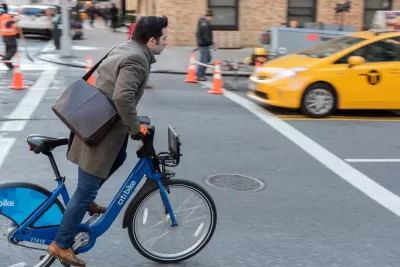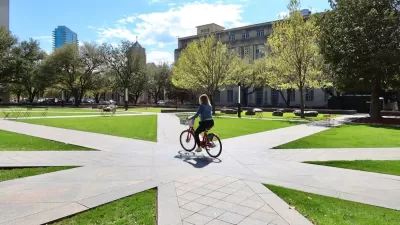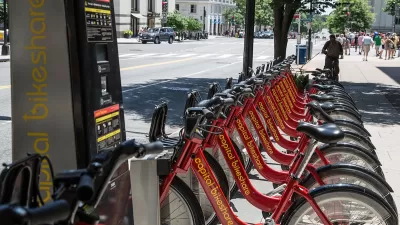The inherent simplicity of bikes makes shared mobility systems a crucial transportation option during natural disasters.

Writing for Bloomberg CityLab, John Surico praises the value of municipal bikeshare systems, which can provide a transportation lifeline during natural disasters or other crises. When Hurricane Ida flooded New York City’s subway system, Surico—and tens of thousands of other New Yorkers—turned to the Citi Bike bikeshare system to get around.
“The nation’s largest bikeshare system clocked 126,360 trips the day after Ida — then the highest in its eight-year history — as bike lanes swarmed with stranded passengers like me,” Surico writes, noting that this held true in other situations.
Citi Bike also broke records this summer during a brutal heat wave that kept subway stations sweltering. When Tube workers went on strike in London in June, Santander Cycles, the city’s bikeshare system, saw riders flocking to it. In Washington, D.C., the Metro’s 2016 repairs led to a 6% increase in ridership for Capital Bikeshare (or CaBi, for short).
The relative simplicity of bikes and bikeshare, Surico writes, “can be particularly useful when other modes are sidelined.” This is why Surico argues that city officials and transit agencies should pay more attention to bikes and the needs of bike users and work to make bikeshare and transit systems complement and support each other.
Jascha Franklin-Hodge, the chief of streets for Boston, noted that the city’s Bluebike bikeshare system was a key alternative for Bostonians when the Orange Line shut down for repairs in August. The city made the system free during the shutdown to ease the transition for commuters. “If you don’t think of bikes as transportation, you will not do the things you need to do to make it a good alternative during a transportation crisis,” Franklin-Hodge said.
FULL STORY: In Times of Crisis, Bikeshare Rolls On

Study: Maui’s Plan to Convert Vacation Rentals to Long-Term Housing Could Cause Nearly $1 Billion Economic Loss
The plan would reduce visitor accommodation by 25,% resulting in 1,900 jobs lost.

North Texas Transit Leaders Tout Benefits of TOD for Growing Region
At a summit focused on transit-oriented development, policymakers discussed how North Texas’ expanded light rail system can serve as a tool for economic growth.

Why Should We Subsidize Public Transportation?
Many public transit agencies face financial stress due to rising costs, declining fare revenue, and declining subsidies. Transit advocates must provide a strong business case for increasing public transit funding.

How Community Science Connects People, Parks, and Biodiversity
Community science engages people of all backgrounds in documenting local biodiversity, strengthening connections to nature, and contributing to global efforts like the City Nature Challenge to build a more inclusive and resilient future.

Alabama: Trump Terminates Settlements for Black Communities Harmed By Raw Sewage
Trump deemed the landmark civil rights agreement “illegal DEI and environmental justice policy.”

Dear Tesla Driver: “It’s not You, It’s Him.”
Amidst a booming bumper sticker industry, one writer offers solace to those asking, “Does this car make me look fascist?”
Urban Design for Planners 1: Software Tools
This six-course series explores essential urban design concepts using open source software and equips planners with the tools they need to participate fully in the urban design process.
Planning for Universal Design
Learn the tools for implementing Universal Design in planning regulations.
City of Santa Clarita
Ascent Environmental
Institute for Housing and Urban Development Studies (IHS)
City of Grandview
Harvard GSD Executive Education
Toledo-Lucas County Plan Commissions
Salt Lake City
NYU Wagner Graduate School of Public Service





























